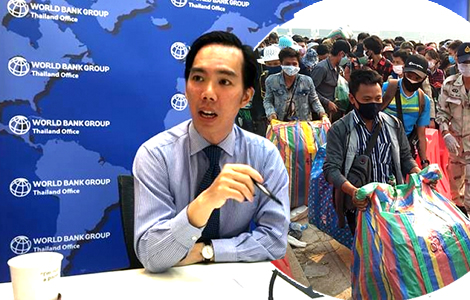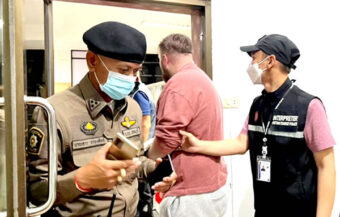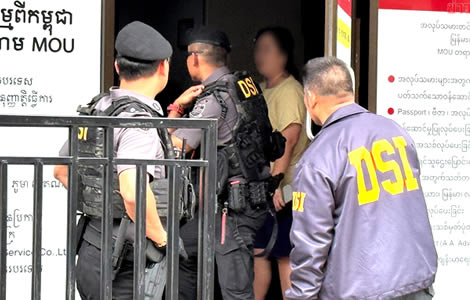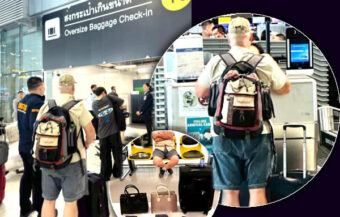Even before the latest fears of a lockdown after the Samut Sakhon outbreak among Myanmar migrant workers, there was a concern for Thai exports in the fourth quarter and a deeper impact on the economy in this period and the opening 3 months of 2021 caused by the absence of foreign tourism in what is traditionally the High Season for the industry when it contributes the most to the Thai economy.
Thailand could be facing a severe hit to its GDP if it fails to bring the threatened Covid 19 outbreak under control, a key executive with the World Bank warned this week. This was followed by signs that the government in the kingdom is weighing up the possibility of further lockdown measures and contingencies even as officials are still hopeful of containing the situation linked with the Covid 19 outbreak in Samut Sakhon last weekend. However, the kingdom’s overall economic outlook is on the line as fears grow that exports may begin to falter while the foreign tourism industry still remains closed. The World Bank is warning the government that it will be 2023 before the economy gets back to pre-pandemic levels and after that, the kingdom will require a minimum of 5% growth per annum from there to 2025 driven by a large expansion in capital expenditure coupled with rapid productivity improvements to reach the goal of becoming a high-income country by 2037.

It is understood that, on Tuesday, the Centre for Covid 19 Situation Administration instructed the Ministry of Public Health to draw up criteria governing lockdowns to be observed by provincial authorities as officials still hope to avoid a full-scale lockdown.
So far, the outbreak in Samut Sakhon has spread to 22 provinces with Bangkok having 16 infections followed by Nakhon Pathom with 10 cases, Chachoengsao with 6 as well as Samut Prakan and Saraburi, each on 5 and Pathum Thani with 3.
World Bank paints a bleak enough picture
The economic reality for Thailand was made crystal clear on Monday by Kiatipong Ariyapruchya, the economist at the World Bank who monitor’s Thailand for the international financial institution.
Mr Kiatipong said that even a partial lockdown, affecting Bangkok and key provinces throughout Thailand, could see the country’s tepid economic recovery falter and potentially cause a decline in GDP akin to that seen in the second quarter when Thailand experienced a contraction of over 12% of GDP.
Officials and the PM assessing the situation
At present, the government is striving to avoid that prospect with Prime Minister Prayut Chan ocha, on Monday, saying he would assess the situation over the coming 7 days and senior public health officials also suggesting this time frame of evaluation of the trend of outward projection as small numbers of infections have begun to appear in provinces still linked with the Samut Sakhon outburst.
Bloomberg, the New York based financial media outlet, reported on Tuesday that Thailand is already facing the prospect of being the Asian economy facing the stiffest challenge in recovering from the virus emergency.
The country was already faced with particular vulnerabilities before the beginning of this year including regional competition, its reliance on tourism and a worsening demographics situation affecting its labour force.
Twin engines of the economy are still tourism and exports which make up 70% of the kingdom’s GDP
The reason is simple. The Thai economy, despite talk of the country’s senior policymakers to the contrary and a new technology orientated vision of the future, is still very much dependent on both tourism and exports to fuel economic growth. Between them, they account for 70% of output and perhaps more.
The outbreak in Samut Sakhon among migrant workers from Myanmar highlights, also, another key and growing problem for Thailand and that is a labour shortage to undertake manual work in the kingdom.
Shrimp and seafood processing is a key income generator for the Thai economy but yet only 10% of those employed at the busy Samut Sakhon Mahachai market were Thai workers.
On Thursday, it was confirmed by Thai officials that there are over 300,000 migrant workers alone working in Samut Sakhon province mostly from Myanmar. Officials pointed out that this did not include illegal workers in the province who are unregistered.
Lowest level of rice exports in two decades
Thailand also reported the worst rice export performance in two decades, in recent days, with exporters suggesting that part of the problem hindering their efforts is a chronic shortage of both export shipping containers and manpower to load ships.
The President of the Rice Exporters Association, this week, Charoen Laothamatas, admitted that, for the first time, exports from Thailand would be lower in volume than that from the country’s key economic competitor both for trade and investment, Vietnam.
Exports of rice are projected to be down 12% this year at 5.7 million tonnes valued at ฿115 billion.
Problem in the United States may impact Thailand’s recovering exports to the West in the short term
This, added to by the severe outbreak of Covid 19 in Europe and the United States, which has been Thailand’s best export market in 2020 so far and the basis for a recovery in the third quarter, already means the kingdom’s outlook is altered.
Exports to the European Union, which have already been extremely disappointing this year, may even decline further due to widespread lockdowns on the continent while a significant strengthening of the baht from early November will also make Thai products less competitive.
The World Bank has projected steeper GDP contraction in Thailand than most analysts at 8.3% for 2020 and up to 4.89% growth for 2021. The latter is in line with the government’s own outlook.
It is suggesting that it will be well into 2023 before the Thai economy has recovered its GDP to pre-pandemic levels.
Loss in GDP for Samut Sakhon province alone estimated at ฿1 billion per day by business leaders
In recent days, business leaders in Samut Sakhon province have estimated that the loss to the economy, in that area alone, linked with the shrimp and fish processing industry and other business closures, could be as high as ฿1 billion a day.
This was according to Amphai Harnkraiwilai, the chairwoman of the Samut Sakhon Chamber of Commerce who said that the province’s seafood industry made up ฿450 to ฿500 million of that per day.
In addition, even as tourists continue to arrive in small numbers, at levels not even approaching 1% of the normal traffic seen last year, the loss of Thailand’s foreign tourism industry is being distinctly felt.
It has been estimated that Thailand is losing up to ฿8 billion a day in direct foreign earnings that normally flushed its way through both the official economy and the country’s huge informal sector.
Hotels reporting bookings at 30%
Hotels that are currently reporting a moderate improvement from earlier this year, based on domestic tourism, with reports of a 30% bookings rate, would normally be booked out at this time of year.
The loss of foreign tourism will be felt sharply in the final figures for the fourth quarter and first quarter of next year as the industry’s net contribution to GDP and ancillary industry spinoff effects on areas such as retail, construction and the entertainment sector means that it accounts for up to 20% of Thailand’s GDP in real terms as opposed to the 11.8% calculated on a technical basis.
Challenge from 2023 to 2025 is to record consistent growth in excess of 5% to achieve the goal
This means that the long term ambitions of Thailand’s economic planners are also being thwarted severely by the virus emergency.
The World Bank now says that the country will have to move to beyond 5% growth per annum by 2023 and maintain momentum at this level growth through to 2025, at a minimum, to emerge in 2037 as a high-income economy
The 2037 target is the current official target laid down by Thailand’s National Economic and Social Development Board.
However, the World Bank, in its review of Thailand’s economic situation, has pointed to a need for the government to double the level of capital expenditure and investment in the country’s infrastructure and greatly improve the productivity levels of workers to increase annual incomes and expand the economy.
Thailand’s problems are declining demographics and competition, it’s major opportunity is its position
A key challenge faced by the government is that the potential working age population pool in Thailand is declining due to its demographics which means urgent efforts are required to upgrade the kingdom’s education system to fuel increased productivity.
‘Increasing the productivity of firms within the manufacturing sector itself will also play a key role in job creation and more inclusive growth particularly in the post-Covid recovery phase,’ said Birgit Hansl who is World Bank country manager for Thailand.
The problem for Thailand is that it is facing stiff competition from Asian neighbours, some with younger populations and a stronger emphasis on education.
However, its opportunity may still be its accepted position in Asia as a centre point to major markets notably China and India.
Diligent and adaptive workforce
On the plus side, Thai workers have long been recognised for their diligence and ability to adapt new ideas and circumstances.
However, even before the Covid 19 outbreak, the kingdom was facing economic headwinds caused by the dramatic changes brought about by the US-China trade war in supply chains which has, in turn, sparked a move away from manufacturing in Asia as western countries can now deploy technology and robotics to bring employment home on a cost-effective basis.
Thailand’s National Statistics Office shows that Thailand’s labour force participation rate reached its lowest point in October 2019 at 66.15% and despite the Covid 19 emergency, this has risen slightly to 68.2% in October 2020.
Its highest point was over 78 in 2013 when the measurement began to be looked at.
Half are still under 35 years of age
Even with the negative effects of ageing demographics and its potential for problems in the future, the majority of the Thai workforce is still under 35 with a greater concentration of 25 to 35-year-olds. The kingdom’s average salary is ฿13,800 per month which has been rising. There are 38 million people in the Thai workforce.
The challenge facing the country is to find employment for growing numbers of university graduates.
Problem facing university graduates in 2020
Unicef, in an August study, warned that there may be up to 300,000 Thai university graduates who cannot find employment due to the Covid-19 challenge this year and this has been shown in the uptick in the unemployment rate among younger adults which stands at 4.9% or seven times the national average,
‘Covid-19 is expected to hit young people harder, who are at a higher risk of unemployment and precarious employment than adults. In addition to building a more inclusive social protection system for all, ensuring that young people can gain access to decent jobs will help ensure their access to some form of social protection, now more important than ever,’ said Beena Kuttiparambil of UNICEF Thailand in August.
Thailand’s education system faces questions as disruptive technology takes away old fashioned jobs
Clearly, there is a change occurring in Thailand being led by the younger generation. The question is, can the government deliver on the promises as Thailand attempts to leverage the country into a new, brighter economic reality?
This is not just an aspiration but a necessity which cannot be avoided due to the effects of disruptive technology which have already meant that young people are finding it more difficult to find suitable employment opportunities.
A key problem is the country’s education system with Thailand lagging behind the OECD average in mathematics and science and more crucially, other countries within the ASEAN community.
Get all our latest stories, follow Thai Examiner on Facebook here
Further reading:
Challenge of the virus and closure to tourism leads to major long term changes in the Thai economy
Finance Minister says economy must pivot away from tourism with a switch to S-Curve industries
Strengthening baht predicted as investors bet on a reopening of Thailand to mass tourism in 2021
World’s biggest free trade deal just signed will be a huge boost for the Thai economy and exports
RCEP deal agreed as India opts out – busy Bangkok ASEAN summit concludes on a low key
Chinese FM to visit Thailand in a Covid battered world of raised tensions and potential conflict
Prime Minister indicates that the cabinet reshuffle will be complete very shortly with no problem
Thailand’s economy has become dependent on government expenditure to stay above water
Thailand and US aim for a new more ‘proactive’ trading relationship as ambassador meets Prayuth
Rice price spike but drought conditions to recede – security concern for the Mekong river
US suspension of Thai preferential trade partner status part of Trump’s ongoing trade war


















